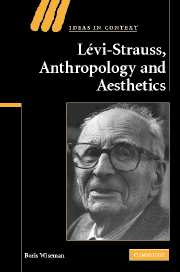Book contents
- Frontmatter
- Contents
- List of illustrations
- Acknowledgements
- Introduction: ethno-aesthetics
- 1 The reconciliation
- 2 Art and the logic of sensible qualities
- 3 The work of art as a system of signs
- 4 Structuralism, Symbolist poetics and abstract art
- 5 The anthropologist as art critic
- 6 Nature, culture, chance
- 7 From myth to music
- 8 Lévi-Strauss's mytho-poem
- Conclusion: between concept and metaphor
- References
- Index
- IDEAS IN CONTEXT
4 - Structuralism, Symbolist poetics and abstract art
Published online by Cambridge University Press: 27 October 2009
- Frontmatter
- Contents
- List of illustrations
- Acknowledgements
- Introduction: ethno-aesthetics
- 1 The reconciliation
- 2 Art and the logic of sensible qualities
- 3 The work of art as a system of signs
- 4 Structuralism, Symbolist poetics and abstract art
- 5 The anthropologist as art critic
- 6 Nature, culture, chance
- 7 From myth to music
- 8 Lévi-Strauss's mytho-poem
- Conclusion: between concept and metaphor
- References
- Index
- IDEAS IN CONTEXT
Summary
In the preceding chapter I have considered the implications of the connection made by Lévi-Strauss between art and so-called ‘wild’ thinking for a theory of the production of the aesthetic sign and what this connection tells us about some of art's modes of signification. The lesson of structuralism, here, is that in addition to any denotative or referential function, the aesthetic sign mediates between mind and world. The aesthetic sign is not – or is not only – that which figures or more generally ‘points’ to the world; it is constitutive of a particular experience of it. The world is not apprehended in a work of art, but through it. In this chapter, I would like to look more closely at the implications of Lévi-Strauss's understanding of the functioning of concrete logic for a theory of the ‘consumption’ of the aesthetic sign. To do this, I will examine an aspect of the genealogy of structuralism, whose importance for a general understanding of Lévi-Strauss's works has already been demonstrated by James Boon in From Symbolism to Structuralism: Lévi-Strauss in a Literary Tradition. As Boon realised very well, structuralism is deeply connected to the current of ideas in French culture that led from Baudelaire to the Symbolist and post-Symbolist poets. He shows that one of the dominant paradigms of twentieth-century anthropological theory originated, in part at least, in a literary movement.
- Type
- Chapter
- Information
- Levi-Strauss, Anthropology, and Aesthetics , pp. 100 - 118Publisher: Cambridge University PressPrint publication year: 2007



